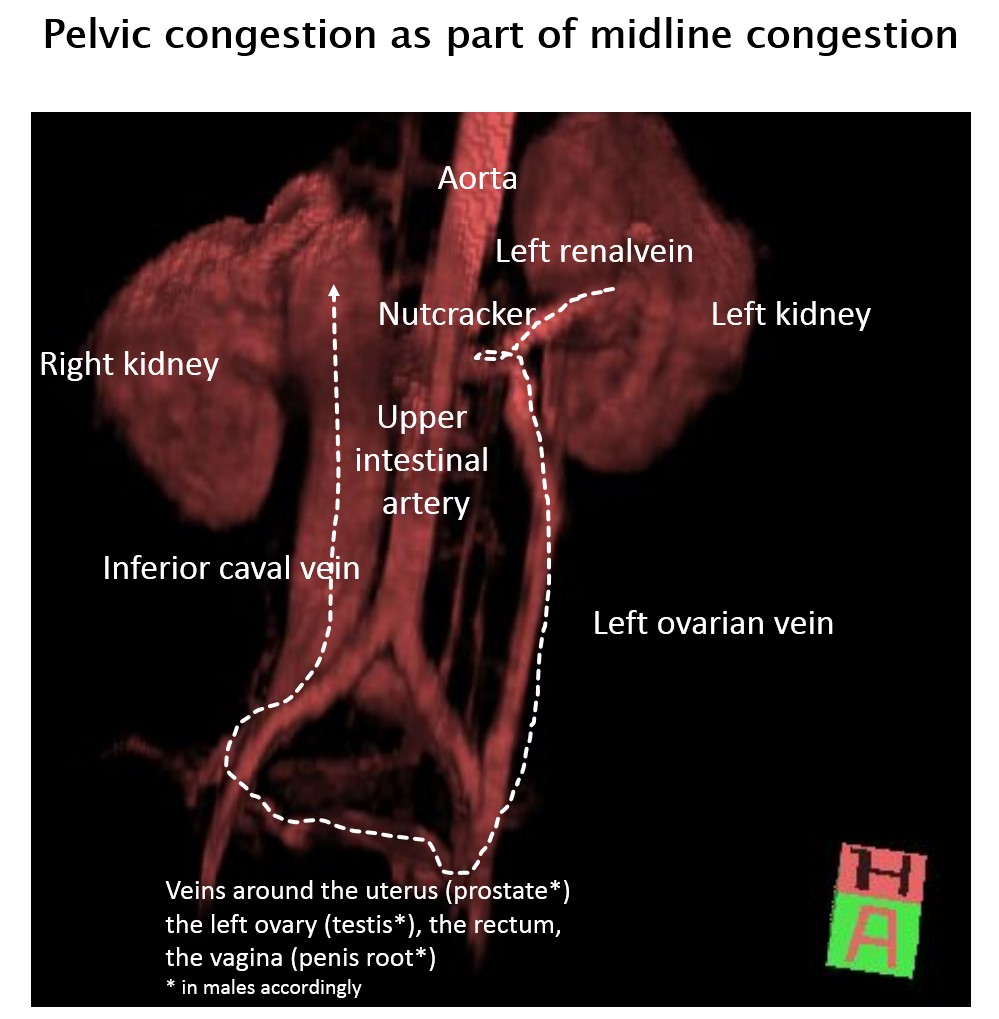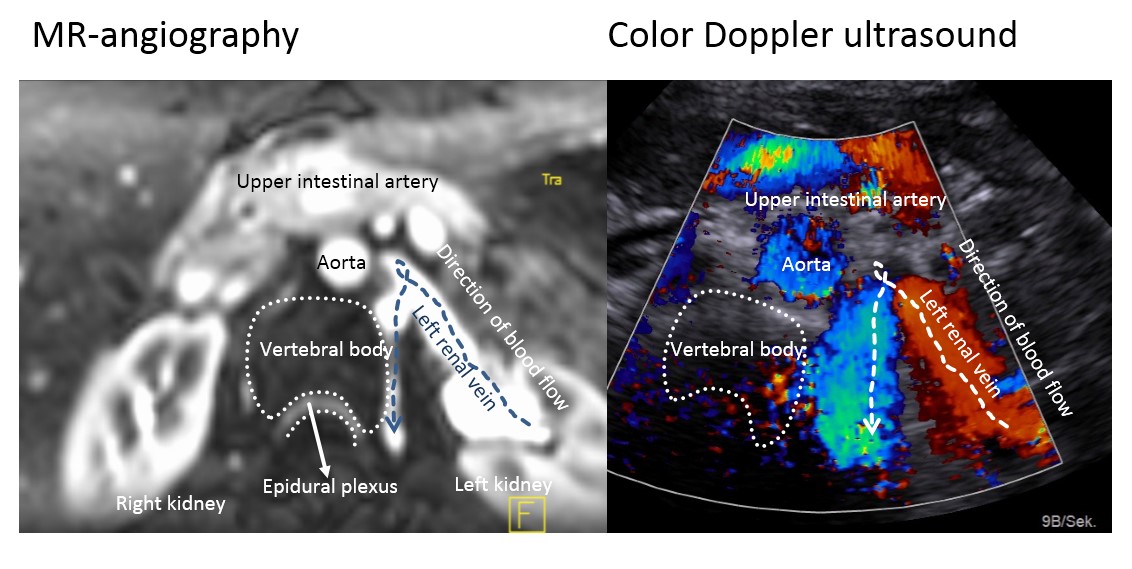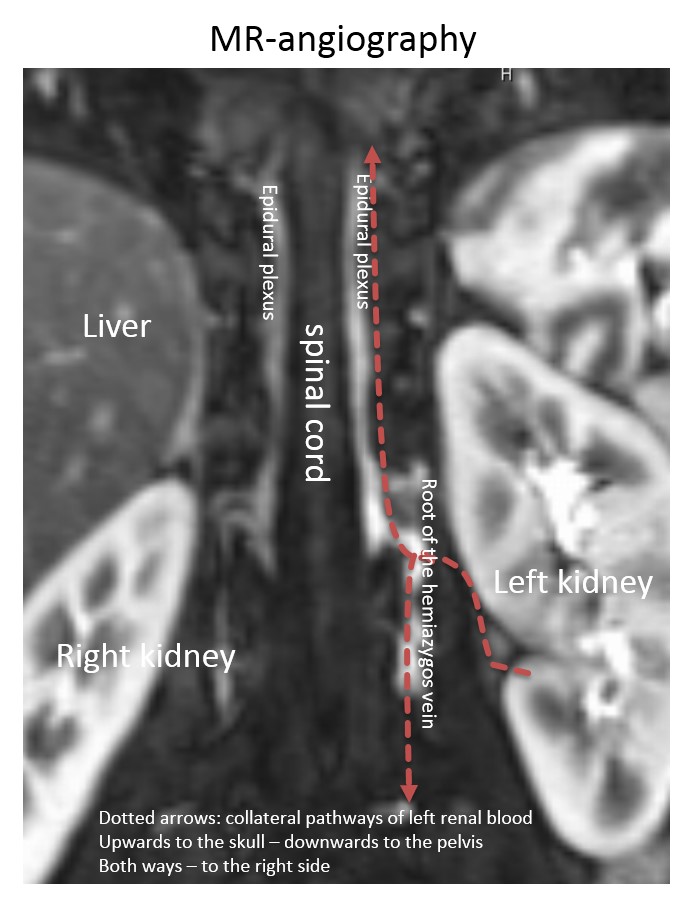- New stuff to read and discuss
- What patients say
- Clinic / online appointments
- Why the diagnosis of a psychosomatic illness is often a misdiagnosis
- Vascular Compression Syndromes
- Do you have questions?
- Checklist vascular compression syndromes
- Description of your symptoms
- Researchers from the Mayo Clinic confirm my concept of the Midline Congestion Syndrome
- Explanation of gender-specific differences in the clinical symptoms of abdominal vascular compression syndromes: varicocele and penile/testicular pain – their main manifestation in men.
- Varicocoele is predominantly caused by left renal vein compression
- Musculoskeletal pecularities of female puberty
- Lordosis /Swayback- Origin of many abdominal compression syndromes
- Bending of a straight vein compels its narrowing
- The lordogenetic midline congestion syndrome
- Neurological consequences of the midline congestion syndrome
- Successful treatment of a teenage girl who was unable to eat due to extreme postprandial pain and unable to walk due to spasticity in her left leg
- Severe ataxia in a young woman with severe spinal congestion – complete resolution after decompression of the left renal vein
- All compression syndromes are one: the spectrum of lordogenetic compressions
- Nutcracker-Syndrome is a misnomer! Lordogenetic left renal vein compression is a more appropriate name!
- May-Thurner-constellation (May-Thurner-syndrome, Cockett’s syndrome)
- Midline (congestion) syndrome
- Pelvic congestion syndrome
- Celiac Trunk Compression / Dunbar syndrome / MALS / Arcuate ligament syndrome
- Wilkie-Syndrome / Superior-mesenteric-artery-syndrome
- Compression of the vena cava inferior
- Evlauation of vascular compressions with the PixelFlux-method
- Connective tissue disorders predispose to multiple compressions
- Postural tachycardia syndrome (POTS) – the hemodynamic consequence of vascular compression syndromes and loose connective tissue
- Restless legs-a little known symptom of abdominal vascular compression syndromes
- Pudendal neuralgia in vascular compression syndromes
- A new sonographic sign of severe orthostatic venous pooling
- Migraine and Multiple Sclerosis
- Hemodynamic effect on cerebral perfusion in patients with multiple localised vascular compression.
- Treatment of vascular compression syndromes
- Fatal errors in the treatment of vascular compression syndromes
- Risks of stents in venous compression syndromes
- Surgical treatment of abdominal compression syndromes: The significance of hypermobility‐related disorders
- Nutcracker and May-Thurner syndrome: Decompression by extra venous tube grafting and significance of hypermobility related disorders
- Our surgical treatment of vascular compressions
- Chronic regional pain syndrome (CRPS) caused by venous compression and mechanical irritation of the coeliac plexus
- Vascular compression syndromes I recently detected
- Kaleidoscope of instructive cases
- Ultrasound Diagnostics
- Profile
- Functional colour Doppler ultrasound – how I do it
- Perfusion Measurement – PixelFlux-method
- Research
- Publications
- Nutcracker and May-Thurner syndrome: Decompression by extra venous tube grafting and significance of hypermobility related disorders
- Papers authored by Th. Scholbach
- Publications
- Inauguration of measurements of the tissue pulsatility index in renal transplants
- From nutcracker phenomenon to midline congestion syndrome and its treatment with aspirin
- First sonographic tissue perfusion measurement in renal transplants
- First sonographic bowel wall perfusion measurement in Crohn disease
- First sonographic renal tissue perfuison measurement
- First sonographic measurement of renal perfusion loss in diabetes mellitus
- PixelFlux measurements of renal tissue perfusion
- Why I prefer not to publish in journals but in the Internet
- Vessel stretching in nephroptosis – an important driver of complaints
- Publications
- Expertise
- Bornavirus Infection
- Scientific cooperation
- Cookie Policy
- Data protection
- Cookie Policy (EU)
- Impressum

Pelvic congestion syndrome
The Pelvic Congestion Syndrome is based on the venous congestion in the pelvic area, mainly in the so-called small (deep) pelvis. There are two ways of its development.
In the simplest case, the veins that drain the blood from the pelvis into the inferior vena cava are too narrow, compressed or blocked.
In addition, blood from the left renal vein can be diverted into small pelvic organs (see “Nutcracker Syndrome”) and then contribute to the overload of the pelvic veins.
Often both possibilities combine and lead to particularly strong symptoms.
Frequent symptoms of pelvic venous congestion are:
- abdominal pain (often left-sided)
- severe pain in the pelvic area (between the symphysis and the navel)
- increased menstrual cramps
- strong or stronger menstrual bleeding
- pain during sexual intercourse (dyspareunia)
- pain in the external genitals – sometimes indiscernable from pudendal nerve entrapment (pudendal neuralgia)
- permanent unpleasant sexual arousal
- congestion in the genital area (especially in women who had multiple deliveries)
- swelling of the vulva – permanent tension within the vulva
- pain during bowel movements
- urgency and painful urination
- bloody urine (mostly as invisible traces, detectbale only under the microscope or with a urine test strip – microhematuria)
- hemorrhoids – bleeding during defecation
- deep anal pain
- varicose veins in the groin and on the external genitalia
- fullness an weakness of the left, later also of the right leg
- swollen legs
- thrombosis – often predominantly of the left leg
- erectile dysfunction – sometimes priapism (unpleasant long-lasting penile erection)
- varicocele (filling of the scrotal sac with wormlike venous vessels – sometimes painful, often uncomfortable, sometimes interfering with spermiogenesis)

The chronically over-stretched veins meander as so-called varices (“varicose veins” – varix is of Latin origin and means knobby, dilated vein) and cause pain and discomfort emerging in the wall of the vein and in the congested organs as well. Many women (and postpubertal girls) complain of pain in the left lower abdomen (area of the left ovary) and men complain about discomfort and pain in left testicle.
The video below shows the typical path of blood from the obstructed left renal vein through the tortuous and dilated left ovarian vein to the veins surrounding the uterus. Without an accurate diagnosis of left renal vein compression, conventional treatment of pelvic congestion often fails. Unfortunately, patients are offered treatment for pelvic congestion by ligating or clamping the left ovarian vein or, even worse, hysterectomy. However, the blood accumulated in the left renal vein finds a way and recruits new collaterals to replace the left ovarian vein, so that the symptoms of pelvic congestion inevitably recur within a few weeks to 3 months if no decompression of the left renal vein has been performed.

Sketch of typical collateral pathways: The blood from the left kidney runs against the nutcracker, then turns downwards via the left ovarian vein into the vast pool of retroperitoneal veins around the uterus. From there, via the veins on the right side of the uterus, it reaches the inferior vena cava(MR angiogram)

Upper abdominal cross section – view from below In MR angiography and ultrasound, the congestion of the consecutively enlarged left renal vein is shown along with path of the blood through a tronc réno-rachidien to the veins of the spinal column, in- and outside

Representation of the left-sided collateral veins along the spinal column and cord in MR angiography
In pelvic congestion, pain in the lower abdomen or in the left testicle results from the diversion of blood from the left kidney to the organs of the pelvis. This blood is drained via the ascending lumbar vein and the left ovarian (in males*: spermatic) vein into the pelvis. This additional volume needs to be transported to the inferior vena cava, which runs at the right side of the spine. Within the pelvis a vast network of veins fills the space between the organs, mainly the uterus (prostate*), rectum, urinary bladder and vagina. This network takes up the renal blood from the left kidney but may soon be overfilled. If so, complaints emerge. These consist mainly of painful sensations at rest, during voiding, bowel movements, menstruation or sexual intercourse. Sometimes bleeding occurs from the hemorrhoidal venous plexus of the anus, sometimes bloody urine is observed. Voiding may be very urgent and frequent resulting in little amounts of urine only. This situation is very often misinterpreted as urinary bladder inflammation, infection or pyelonephritis, especially since red blood cells are often found in the urine, but white blood cells, characteristic for all kinds of inflammation, are missing.
The pressure in the deep pelvic veins may rise to an amount that the main left sided pelvic vein, the left common iliac vein may be filled mainly by the blood coming from the left kidney. Since the left common iliac vein also takes up blood from the left leg, via the left external iliac vein, this blood may be partially blocked. A congestion of the left leg, left thigh and the left parts of the genitalia results. In women with multiple pregnancies, varices of the left groin, tenderness and pain may result. Sometimes a fullness of the clitoris and the labia majora and minora with unsolicited sexual arousal occurs and may be bothering. Thrombosis of the deep veins of the left leg, mainly of the calf, and varices of the left leg may develop.
To get access to the inferior vena cava, left renal blood is thus pressed partly across deep veins of the pelvic plexus, partly across the left common iliac vein. But this large vessel may also be blocked in persons who have a strong lumbar lordosis. In this case the promontory is especially prominent and sticks out frontally into the pelvis from behind. This compression of the left common iliac vein by the overlying right common iliac artery against the promontory is known, after its first description by two Swiss physicians, as May-Thurner-constellation.
A more detailed desription of vascular compression syndromes can be downloaded here.
